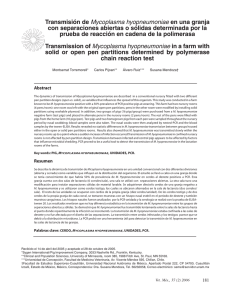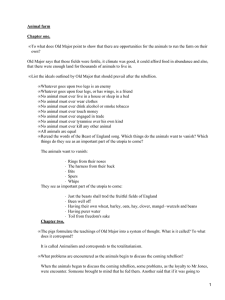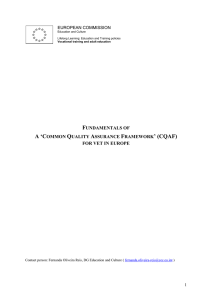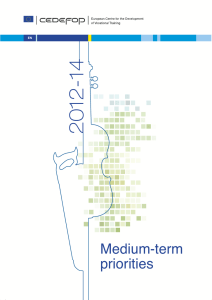Detection of pathogens in pigs with pneumonia in different regions
Anuncio
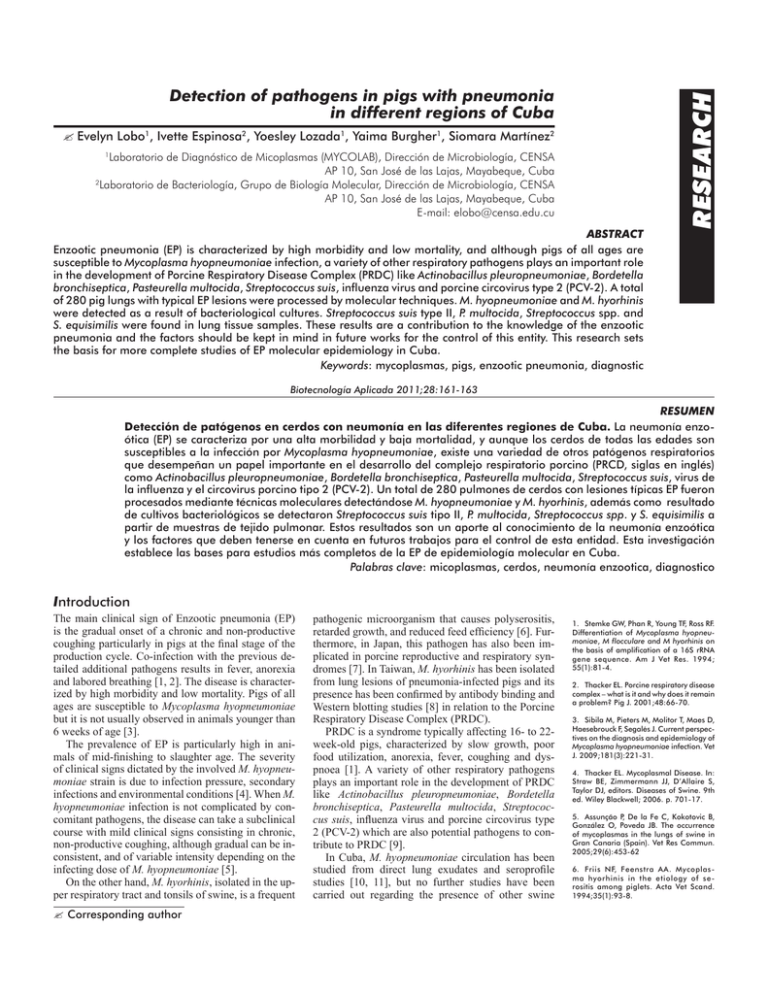
" Evelyn Lobo1, Ivette Espinosa2, Yoesley Lozada1, Yaima Burgher1, Siomara Martínez2 Laboratorio de Diagnóstico de Micoplasmas (MYCOLAB), Dirección de Microbiología, CENSA AP 10, San José de las Lajas, Mayabeque, Cuba 2 Laboratorio de Bacteriología, Grupo de Biología Molecular, Dirección de Microbiología, CENSA AP 10, San José de las Lajas, Mayabeque, Cuba E-mail: elobo@censa.edu.cu 1 ABSTRACT Enzootic pneumonia (EP) is characterized by high morbidity and low mortality, and although pigs of all ages are susceptible to Mycoplasma hyopneumoniae infection, a variety of other respiratory pathogens plays an important role in the development of Porcine Respiratory Disease Complex (PRDC) like Actinobacillus pleuropneumoniae, Bordetella bronchiseptica, Pasteurella multocida, Streptococcus suis, influenza virus and porcine circovirus type 2 (PCV-2). A total of 280 pig lungs with typical EP lesions were processed by molecular techniques. M. hyopneumoniae and M. hyorhinis were detected as a result of bacteriological cultures. Streptococcus suis type II, P. multocida, Streptococcus spp. and S. equisimilis were found in lung tissue samples. These results are a contribution to the knowledge of the enzootic pneumonia and the factors should be kept in mind in future works for the control of this entity. This research sets the basis for more complete studies of EP molecular epidemiology in Cuba. Keywords: mycoplasmas, pigs, enzootic pneumonia, diagnostic RESEARCH Detection of pathogens in pigs with pneumonia in different regions of Cuba Biotecnología Aplicada 2011;28:161-163 RESUMEN Detección de patógenos en cerdos con neumonía en las diferentes regiones de Cuba. La neumonía enzoótica (EP) se caracteriza por una alta morbilidad y baja mortalidad, y aunque los cerdos de todas las edades son susceptibles a la infección por Mycoplasma hyopneumoniae, existe una variedad de otros patógenos respiratorios que desempeñan un papel importante en el desarrollo del complejo respiratorio porcino (PRCD, siglas en inglés) como Actinobacillus pleuropneumoniae, Bordetella bronchiseptica, Pasteurella multocida, Streptococcus suis, virus de la influenza y el circovirus porcino tipo 2 (PCV-2). Un total de 280 pulmones de cerdos con lesiones típicas EP fueron procesados mediante técnicas moleculares detectándose M. hyopneumoniae y M. hyorhinis, además como resultado de cultivos bacteriológicos se detectaron Streptococcus suis tipo II, P. multocida, Streptococcus spp. y S. equisimilis a partir de muestras de tejido pulmonar. Estos resultados son un aporte al conocimiento de la neumonía enzoótica y los factores que deben tenerse en cuenta en futuros trabajos para el control de esta entidad. Esta investigación establece las bases para estudios más completos de la EP de epidemiología molecular en Cuba. Palabras clave: micoplasmas, cerdos, neumonía enzootica, diagnostico Introduction The main clinical sign of Enzootic pneumonia (EP) is the gradual onset of a chronic and non-productive coughing particularly in pigs at the final stage of the production cycle. Co-infection with the previous detailed additional pathogens results in fever, anorexia and labored breathing [1, 2]. The disease is characterized by high morbidity and low mortality. Pigs of all ages are susceptible to Mycoplasma hyopneumoniae but it is not usually observed in animals younger than 6 weeks of age [3]. The prevalence of EP is particularly high in animals of mid-finishing to slaughter age. The severity of clinical signs dictated by the involved M. hyopneumoniae strain is due to infection pressure, secondary infections and environmental conditions [4]. When M. hyopneumoniae infection is not complicated by concomitant pathogens, the disease can take a subclinical course with mild clinical signs consisting in chronic, non-productive coughing, although gradual can be inconsistent, and of variable intensity depending on the infecting dose of M. hyopneumoniae [5]. On the other hand, M. hyorhinis, isolated in the upper respiratory tract and tonsils of swine, is a frequent " Corresponding author pathogenic microorganism that causes polyserositis, retarded growth, and reduced feed efficiency [6]. Furthermore, in Japan, this pathogen has also been implicated in porcine reproductive and respiratory syndromes [7]. In Taiwan, M. hyorhinis has been isolated from lung lesions of pneumonia-infected pigs and its presence has been confirmed by antibody binding and Western blotting studies [8] in relation to the Porcine Respiratory Disease Complex (PRDC). PRDC is a syndrome typically affecting 16- to 22week-old pigs, characterized by slow growth, poor food utilization, anorexia, fever, coughing and dyspnoea [1]. A variety of other respiratory pathogens plays an important role in the development of PRDC like Actinobacillus pleuropneumoniae, Bordetella bronchiseptica, Pasteurella multocida, Streptococcus suis, influenza virus and porcine circovirus type 2 (PCV-2) which are also potential pathogens to contribute to PRDC [9]. In Cuba, M. hyopneumoniae circulation has been studied from direct lung exudates and seroprofile studies [10, 11], but no further studies have been carried out regarding the presence of other swine 1. Stemke GW, Phan R, Young TF, Ross RF. Differentiation of Mycoplasma hyopneumoniae, M flocculare and M hyorhinis on the basis of amplification of a 16S rRNA gene sequence. Am J Vet Res. 1994; 55(1):81-4. 2. Thacker EL. Porcine respiratory disease complex – what is it and why does it remain a problem? Pig J. 2001;48:66-70. 3. Sibila M, Pieters M, Molitor T, Maes D, Haesebrouck F, Segalés J. Current perspectives on the diagnosis and epidemiology of Mycoplasma hyopneumoniae infection. Vet J. 2009;181(3):221-31. 4. Thacker EL. Mycoplasmal Disease. In: Straw BE, Zimmermann JJ, D’Allaire S, Taylor DJ, editors. Diseases of Swine. 9th ed. Wiley Blackwell; 2006. p. 701-17. 5. Assunção P, De la Fe C, Kokotovic B, González O, Poveda JB. The occurrence of mycoplasmas in the lungs of swine in Gran Canaria (Spain). Vet Res Commun. 2005;29(6):453-62 6. Friis NF, Feenstra AA. Mycoplasma hyorhinis in the etiology of serositis among piglets. Acta Vet Scand. 1994;35(1):93-8. Evelyn Lobo et al. Detection of pathogens in pigs mycoplasmas and bacteria that may be circulating in the island associated to PRDC, hence the objective of the present work was to detect the presence of swine mycoplasmas and bacteria from exudates of pig lungs with typical EP lesions in different regions of the country. Table 1. Oligonucleotide primers used for specific identification of mycoplasma isolated Materials and methods A total of 280 pig lungs with typical EP lesions (35 per province) was processed between October, 2007, (Pinar del Río, Mayabeque and Matanzas provinces) and January, 2008, (Cienfuegos, Villa Clara, Ciego de Avila, Sancti Spiritus and Camagüey). These samples were taken in the regional slaughterhouse La Española and, in all the cases, lungs were transported to MYCOLAB to be immediately processed with the transfer conditions established by biosafety. Samples were taken in the apical, frontal, medial and diaphragmatic lobules. They were processed as follows. A piece of pulmonary lobule that had been previously introduced into 70 ºC alcohol was flamed and an incision was made using an also flamed scalpel to reach the pulmonary parenchyma with a sterile swab, thus avoiding contamination due to manipulation. Swabs were introduced into Eppendorf tubes containing 250 μL of sterile PBS and centrifuged at 14 000 rpm for 2 min. The liquid obtained was then collected. DNA was extracted according to Fernández et al. [12]. It was based on sample subjected to a combination of thermal shocks and centrifugation. Strains of M. hyorhinis (ATCC 10130) and M. hyopneumoniae (J, NCTC 10110) were used as positive controls. Oligonucleotide primers (Table) and PCR conditions used specific identification of M. hyorhinis and M. hyopneumoniae, described by Caron et al. [13] and Mattson et al. [14]. The mixture was prepared using the KITPuRetaqTM Ready-To-Go PCR Beads kit, from BIO-RAD; amplification was done in a volume of 25 μL, in each case, 1 μL of each primer, 18 μL of ultra pure water and 5 μL of the problem DNA. For each reaction, DNA from the reference strain was used as the positive control and sterile bidistilled water was used as the negative control. The thermal profile of the reaction for M. hyopneumoniae included an initial step at 95 ºC for 4 min followed by 35 cycles consisting of denaturation step at 95 ºC for 0.75 min, annealing at 59 ºC for 1 min. and extension at 72 ºC for 2 min. A final extension step at 72 ºC for 10 min was also included. In the case of M. hyorhinis, the thermal profile for the reaction included an initial step at 94 ºC for 3 min, followed by 35 cycles consisting of desnaturation step at 94 ºC for 1 min, annealing at 50 ºC for 1 min and extension at 72 ºC for 1.5 min. A final extension step at 72 ºC for 10 min was also included. All PCR reactions were performed in Mastercycler Gradient thermocycler (Eppendorf). Aliquots of amplified samples (5 μL) were analyzed by electrophoresis 2% in agarose gel. The gel was stained with ethidium bromide (0.5 μg/mL) and photographed under UV illumination. The samples were cultured bacteriologically on the day they were collected, and a semiquantitative examination for specific colony types was performed. The Mycoplasma species Oligonucleotide primers Amplicom (size) M. hyorhinisa MYHR 1 MYHR 2 5´GTA GTC AAG CAA GAG GAT GT 3´ 5´GCT GGA GTT ATT ATA CCA GGA 3´ 346 bp M.hyopneumoniaeb MYPN 1 MYPN 2 5´GAC CCT TCA AGC TTC ACC AAG A 3´ 5´ TGT GTT AGT GAC TTT TGC CAC C 3´ 649 bp Primers sequence as reported in reference [4]. Primers sequence as reported in reference [13]. a b following media used were: Columbia agar, Columbia agar supplemented with 5 per cent of fibrinated sheep blood and Mac Conkey agar. Bacterial species were differentiated using commercial test kits (Enterotube API kits; bioMérieux). Results and discussion As a result of the PCR, for detecting M. hyorhinis, the amplification of a 364 bp band was observed in 44.8% of the total of the samples tested, which coincided with that obtained by the positive control (reference strain of M. hyorhinis ATCC 10130). As it can be observed in figure 1, the presence of this species was detected in all the provinces. As results from PCR for detecting M. hyopneumoniae, an amplification of 649 bp band was observed in 14.29% of all the samples, coinciding with the obtained by positive control (M. hyopneumoniae ATCC 29052 reference strain) (Figure 2). Positive samples were observed in every province: These results confirm the presence of M. hyopneumoniae from lung samples coming from the west and central part of the island. 1 2 3 4 5 6 364 bp Figure 1. PCR of M. hyorhinis, on 2% agarose gel, with representative samples of the different regions of the country. Lane 1: molecular weight marker of 100 bp; Lane 2: DNA of M. hyorhinis (strain ATCC 10130) used as positive control; Lane 3: sample from Mayabeque; Lane 4: sample from Villa Clara, Lane 5: sample from Camagüey; Lane 6: Negative control of the reaction (mixture without DNA). 162 Biotecnología Aplicada 2011; Vol.28, No.3 7. Kobayashi H, Morozumi T, Miyamoto C, Shimizu M, Yamada S, Ohashi S, et al. Mycoplasma hyorhinis infection levels in lungs of piglets with porcine reproductive and respiratory syndrome (PRRS). J Vet Med Sci. 1996;58(2):109-13. 8. Lin JH, Chen SP, Yeh KS, Weng CN. Mycoplasma hyorhinis in Taiwan: Diagnosis and isolation of swine pneumonia pathogen. Vet Microbiol. 2006;115(1-3): 111-6. 9. Palzer A, Ritzmann M, Wolf G, Heinritzi K. Associations between pathogens in healthy pigs and pigs with pneumonia. Vet Rec. 2008;162(9):267-71. 10. Abeledo MA, Ruano M, Vega E, Lobo E, Ruedas D. Detección de anticuerpos frente a M. hyopneumoniae en crianzas porcinas mediante un ELISA competitivo. Rev Salud Animal. 2005;27(1):21-5. 11. Lobo E. Mycoplasma hyopneumoniae y su relación con los procesos respiratorios del cerdo. Rev Electrón Vet [Internet]. 2005 Oct [cited 2010 Jul 15];6(10):[about 8 p.]. Available from: http://www.veterinaria. org/revistas/redvet/n101005.html Evelyn Lobo et al. 1 Detection of pathogens in pigs 2 3 4 5 6 649 bp Figure 2. PCR of M. Hyopneumoniae, on 2% agarose gel, with representative samples from different regions of the country. Lane 1: molecular weight marker of 100 bp; Lane 2: DNA from M. hyopneumoniae (ATCC strain used as positive control); Lane 3: Negative control of the reaction (mixture without DNA); Lane 4: sample from Pinar del Río; Lane 5: sample from Matanzas; Lane 6: sample from Ciego de Ávila. It must be pointed out that the 19.84% of the samples tested were positive to M. hyorhinis. This percentage coincides with that reported by Assuncao et al. [5] and Palzer et al. [9], who referred M. hyorhinis as the biggest contaminants of M. hyopneumoniae microbial cultures, and also pointed out its high incidence as an agent of EP etiological picture, respectively. Other specific bacterial agents such as Streptococcus suis type II, Pasteurella multocida, Streptococcus spp. and Streptococcus equisimilis of the lung tissue samples were detected by bacteriological culture. This result is similar to those obtained by Moorkamp et al. [15], who detected respiratory pathogens in porcine lung tissues. Unfortunately, the frequency distribution of micoplasma bacterial isolates could not be found and the pulmonary volume was not weighed up, they were only samples taken from the affected areas regardless the lesion size and affected lobules. In this sense, studies have been conducted about the characteristics and extension of the lesions, area and more affected lobules, finding out their correlation with the isolate incidence or agent detection [16, 17]. The right lung has been usually more affected than the left one, showing a more abundant bronchogenic distribution [18] with the SEP lesions, varying according to the disease phase and the likely secondary complications at the moment of the inspection [17]. In our case, from the 66% of the samples that resulted positive to M. hyorhinis, the highest percentage (22.77%) corresponded to lesions occurring in the apical lobule, 20.37% in the mediastinal lobule and 17.86% corresponded to lesions in the diaphragmatic lobule. This result is similar to those obtained by Assuncao et al. [5] who reported the highest number of detection of pathogenic microorganisms being found in the left apical and mediastinal lobules. On the other hand, Moorkamp et al. [15] and Palzer et al. [9] carried out studies on the incidence percentage of pathogenic microorganisms in swine pneumonia and their interrelation with other agents. Conclusions These results are a contribution to the knowledge of the enzootic pneumonia and the factors should be kept in mind in future works for the control of this entity. This research sets the basis for more complete studies of EP molecular epidemiology in Cuba. 12. Fernández C, Chávez YR. Aplicación de la reacción en cadena de la polimerasa en la detección de micoplasmas. Rev Salud Animal. 1996;18(1):31-4. 13. Caron J, Ouardani M, Dea S. Diagnosis and differentiation of Mycoplasma hyopneumoniae and Mycoplasma hyorhinis infections in pigs by PCR amplification of the p36 and p46 genes. J Clin Microbiol. 2000;38(4):1390-6. 14. Mattsson JG, Bergström K, Wallgren P, Johansson KE. Detection of Mycoplasma hyopneumoniae in nose swabs from pigs by in vitro amplification of the 16S rRNA gene. J Clin Microbiol. 1995;33(4):893-7. 15. Moorkamp L, Nathues H, Spergser J, Tegeler R, Beilage EG. Detection of respiratory pathogens in porcine lung tissue and lavage fluid. Vet J. 2008;175(2):273-5. 16. Maes D, Verdonck M, Deluyker H, Kruif A. Enzootic pneumonia in pigs. Vet Q. 1996;18(3):104-9. Acknowledgements 17. Andrada M, Espinosa de los Monteros A, Rodríguez F, Fernández A, Herráez, P. Patogénesis, signos clínicos y lesiones de la Neumonía Enzoótica Porcina. Porci. 2003;(74):47-68. This work was possible thanks to a Scholarship of the Spanish Agency of International Collaboration (AECID) and the cooperation of Dr José B Poveda and his staff. 18. Gómez-Villamandos JC, Martin de las Mulas J, Quezada M, Carrasco L. Patogenia y signos clínicos-cuadro lesional de la Neumonía Micoplasmica Porcina. Porci. 1995;(27):19-33. Received in August, 2010. Accepted for publication in September, 2011. 163 Biotecnología Aplicada 2011; Vol.28, No.3
